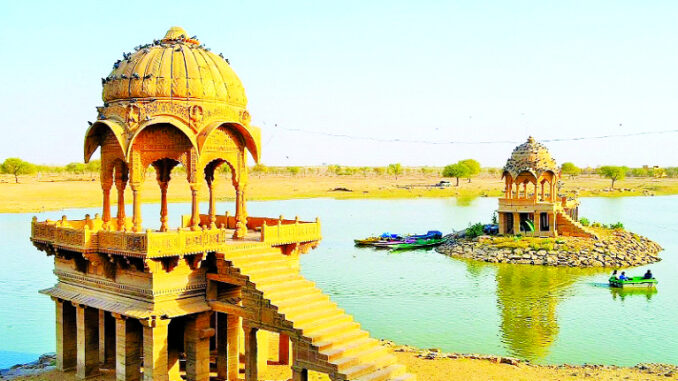
Jaisalmer is a prominent tourist spot located in the northwestern state of Rajasthan in India. It is known as the ‘golden city’ due to its golden dunes and castles clad in golden honey sandstone. Jaisalmer is adorned with lakes, ornate Jain temples and havelis. Climb onto the camel saddle and make your way through this desert to camp under the starry night sky for an unforgettable experience.
The Jaisalmer Fort stands as a citadel with narrow alleys inhabited by people for generations and shops selling colourful handicrafts.
Jaisalmer is a town, and to reach the Sand Dunes, travellers have to take a jeep safari followed by a camel ride. Thus, Jaisalmer is an amalgamation of exotic Indian desert culture, heritage and adventure.
Jaisalmer Fort
Jaisalmer Fort, nestled on the golden sands of Thar Desert, is not just a fort but a mini-town with houses, temples, shops, and restaurants. A UNESCO World Heritage Site, it falls under the category of ‘Hill Forts of India’. Built in 1156, Jaisalmer Fort gets its name from the former Bhati Rajput ruler Rao Jaisal. More than three thousand people live within the fort walls with multiple entrance gates on the path up top, the last of which directs you to the popular public square named Dashera Chowk. The fort stands at an impressive height of 250 ft. and is surrounded by 30 ft. tall walls. Owing to its altitude, it offers a stunning and panoramic view of Jaisalmer city draped in golden yellow!
One of the largest forts in the world, Jaisalmer Fort is located on the southern edge of the city and is popularly known as ‘Sonar Qila’ or ‘Golden Fort’. It is a massive structure exhibiting its aesthetic beauty. The walk through the labyrinthine lanes is an experience worth having. Jaisalmer Fort was initially named ‘Trikut Garh’ since it was triangular in shape and was also built over the Trikuta Hills. ‘Sonar Qila'(Golden Fort) as it is locally referred to, houses almost quarter of Jaisalmer’s population inside the complex.
Desert Safari
Jaisalmer is frequented by tourists for its large stretches of desert sand. Popular Desert Safaris in Jaisalmer takes place in Sam Sand Dunes. A Jeep takes you to a point near Sam Sand Dunes (around 45km from the city) from where the camel ride starts and lasts for around 90 minutes. You will also stop by at a few attractions on your way.
The safaris can be done in the morning or in the evening followed a delicious meal alongside a musical dance program that showcases the local culture of Rajasthan. If you don’t wish to indulge in this experience and want to go for a off-beat experience, there are a few operators like Trotters that will take you to Khuri Sand Dunes. The meal will be modest and the tent will be pitched for you making it perfect for stargazing.
Gadisar Lake
On the outskirts of Jaisalmer in the arid state of Rajasthan lies the beautiful Gadisar Lake, which sits like an oasis in the heart of a desert. Back in the middle ages, there were no canals or irrigation system or other scientific methods to bring water to the arid regions of Rajasthan. This reservoir was built by Raja Rawal Jaisal keeping in mind the need of his people. Located close to the fort of Jaisalmer, the lake is an easy respite from the hot and dry desert climate. Gadisar Lake offers scenic and picturesque views of the lake and the adjacent fort, especially when the eastern sky is blood red and the sun rises, striking its rays on the top floors of Jaisalmer Fort.
Whether you like to spend some quiet time by yourself or have fun with your family, Gadisar Lake has a handful of experiences to offer. You can go boating in the lake or simply enjoy a walk around the embankment. If winter is your time of visit, you might just be lucky enough to see beautiful exotic migratory birds flocking in and around the lake from the nearby bird sanctuary of Bharatpur.
Patwon ki Haveli
Also known as the Mansion of Brocade Merchants, Patwon Ki Haveli is a famous tourist attraction in Jaisalmer, Rajasthan. At first glance from the narrow street it faces, one would see several windows and balconies with intricate carvings, and once inside, they would get to witness the grandeur of the Haveli. It is a cluster of five small havelis built by a rich trader in the 19th Century. Locals also refer the haveli as Kothari’s Patwa Haveli. The five havelis were built for the family and together, the entire complex forms the largest mansion in the city. It still possesses an ample number of artefacts and stonework that give a glimpse into the regal lifestyle of the Patwa family. It is one of three havelis that are deemed impressive in the city. The building comes under the Archaeological Survey of India, and it is recognized as a renowned architectural as well as a historical site.
Sam Sand Dunes
Sam Sand Dunes in Jaisalmer is an offbeat natural tourist destination in Rajasthan right in the middle of the Thar Desert. Right in the middle of the historical forts and colourful markets, Sam Sand Dunes are among the best and most authentic in the country, some rising as tall as 30-60 metres tall. Lying around 40-42 kilometres from the golden city of Jaisalmer, the dunes are located over calm and undulating stretches of golden yellow sand stretching for around 2 kilometres along the borders of the Jaisalmer Desert National Park. Travellers often come here to witness the dramatic and sunrise and sunsets. You can also gain a close insight into the culture and tradition of Rajasthan with dances and musicals that are staged around the campfires at night.
Jain Temples
Situated in the Jaisalmer Fort, Jain Temples in Jaisalmer are a must-visit while you are in the city. The temples, though ancient, have a high religious significance and ancient knowledge attached to them. Built in the Dilwara style that is famous all over the world for its architecture, these temples are dedicated to Rikhabdevji and Shambhavdev Ji, the famous Jain hermits known as ‘Tirthankaras’. Being a significant pilgrimage spot, the Jain Temples are truly a treasure of the Jaisalmer city and a fun place to be at for all those tourists who are interested in history and religion. All the seven temples are connected to each other and are built using the same golden-yellow Jaisalmeri stone.





Be the first to comment